|
Theodor Scheimpflug
Theodor Scheimpflug (7 October 1865 - 22 August 1911) was an Austrian army Captain who elaborated a systematic method and apparatus for correcting perspective distortion in aerial photographs, now known as the eponymous Scheimpflug principle. He disclaimed inventing it however, citing an English patent of the early French photographic engineer Jules Carpentier. Life *Born on 7 October 1865 in Vienna *1897 - Attended college in Vienna *Began Photographic work in 1902 *Died on 22 August 1911 in Mödling Work *Best known for his elaboration of the Scheimpflug principle, which deals with the area of critical focus in a view camera, although he was not the first to describe this principle and never claimed this to be the case. *He was also involved in aerial photography, and held several patents A patent is a type of intellectual property that gives its owner the legal right to exclude others from making, using, or selling an invention for a limited period of time in exch ... [...More Info...] [...Related Items...] OR: [Wikipedia] [Google] [Baidu] |
Vienna
Vienna ( ; ; ) is the capital city, capital, List of largest cities in Austria, most populous city, and one of Federal states of Austria, nine federal states of Austria. It is Austria's primate city, with just over two million inhabitants. Its larger metropolitan area has a population of nearly 2.9 million, representing nearly one-third of the country's population. Vienna is the Culture of Austria, cultural, Economy of Austria, economic, and Politics of Austria, political center of the country, the List of cities in the European Union by population within city limits, fifth-largest city by population in the European Union, and the most-populous of the List of cities and towns on the river Danube, cities on the river Danube. The city lies on the eastern edge of the Vienna Woods (''Wienerwald''), the northeasternmost foothills of the Alps, that separate Vienna from the more western parts of Austria, at the transition to the Pannonian Basin. It sits on the Danube, and is ... [...More Info...] [...Related Items...] OR: [Wikipedia] [Google] [Baidu] |
Mödling
Mödling () is the capital of the Austrian Mödling (district), district of the same name located approximately 15 km south of Vienna. Mödling lies in Lower Austria's industrial zone (Industrieviertel). The Mödlingbach, a brook which rises in the Vienna Woods, flows through the town. Near Achau it joins with the Schwechat. Woodland occupies a large part of the municipality, part of the Föhrenberge ('Pine Mountains'). Located immediately south of Vienna, and within the boundaries of the district of Mödling, is one of the largest shopping centres in Europe: Shopping City Süd (SCS). Geography Grapes are grown on the slopes of the Wienerwald, Austria, Wienerwald; the area is called ''Thermenregion'', where one can find much ''Heurigen'' (the most recent year's wine). Wiener Neudorf to the east, and Maria Enzersdorf to the north, merge directly into Mödling. South of Mödling is Gumpoldskirchen, separated by the Eichkogel with its very special flora. In the west, a nar ... [...More Info...] [...Related Items...] OR: [Wikipedia] [Google] [Baidu] |
Perspective (visual)
Linear or point-projection perspective () is one of two types of graphical projection perspective in the graphic arts; the other is parallel projection. Linear perspective is an approximate representation, generally on a flat surface, of an image as it is seen by the eye. Perspective drawing is useful for representing a three-dimensional scene in a two-dimensional medium, like paper. It is based on the optical fact that for a person an object looks N times (linearly) smaller if it has been moved N times further from the eye than the original distance was. The most characteristic features of linear perspective are that objects appear smaller as their distance from the observer increases, and that they are subject to , meaning that an object's dimensions parallel to the line of sight appear shorter than its dimensions perpendicular to the line of sight. All objects will recede to points in the distance, usually along the horizon line, but also above and below the horizon ... [...More Info...] [...Related Items...] OR: [Wikipedia] [Google] [Baidu] |
Aerial Photograph
Aerial photography (or airborne imagery) is the taking of photographs from an aircraft or other airborne platforms. When taking motion pictures, it is also known as aerial videography. Platforms for aerial photography include fixed-wing aircraft, helicopters, unmanned aerial vehicles (UAVs or "drones"), balloons, blimps and dirigibles, rockets, pigeons, kites, or using action cameras while skydiving or wingsuiting. Handheld cameras may be manually operated by the photographer, while mounted cameras are usually remotely operated or triggered automatically. Aerial photography typically refers specifically to bird's-eye view images that focus on landscapes and surface objects, and should not be confused with air-to-air photography, where one or more aircraft are used as chase planes that "chase" and photograph other aircraft in flight. Elevated photography can also produce bird's-eye images closely resembling aerial photography (despite not actually being aerial sh ... [...More Info...] [...Related Items...] OR: [Wikipedia] [Google] [Baidu] |
Eponym
An eponym is a noun after which or for which someone or something is, or is believed to be, named. Adjectives derived from the word ''eponym'' include ''eponymous'' and ''eponymic''. Eponyms are commonly used for time periods, places, innovations, biological nomenclature, astronomical objects, works of art and media, and tribal names. Various orthographic conventions are used for eponyms. Usage of the word The term ''eponym'' functions in multiple related ways, all based on an explicit relationship between two named things. ''Eponym'' may refer to a person or, less commonly, a place or thing for which someone or something is, or is believed to be, named. ''Eponym'' may also refer to someone or something named after, or believed to be named after, a person or, less commonly, a place or thing. A person, place, or thing named after a particular person share an eponymous relationship. In this way, Elizabeth I of England is the eponym of the Elizabethan era, but the Elizabethan ... [...More Info...] [...Related Items...] OR: [Wikipedia] [Google] [Baidu] |
Scheimpflug Principle
The Scheimpflug principle is a description of the geometric relationship between the orientation of the plane of Focus (optics), focus, the lens plane, and the image plane of an optical system (such as a camera) when the lens plane is not parallel to the image plane. It is applicable to the use of some View camera#Movements, camera movements on a view camera. It is also the principle used in corneal pachymetry, the mapping of corneal topography, done prior to refractive eye surgery such as LASIK, and used for early detection of keratoconus. The principle is named after Austrian army Captain Theodor Scheimpflug, who used it in devising a systematic method and apparatus for correcting Perspective (visual), perspective distortion in aerial photographs, although Captain Scheimpflug himself credits Jules Carpentier with the rule, thus making it an example of Stigler's law of eponymy. Description Normally, the lens and image (film or sensor) planes of a camera are parallel, and ... [...More Info...] [...Related Items...] OR: [Wikipedia] [Google] [Baidu] |
Jules Carpentier
Jules Carpentier (30 August 1851 – 30 June 1921) was a French engineer and inventor. Jules Carpentier was a student at the French École polytechnique. He bought the Ruhmkorff workshops in Paris when Heinrich Daniel Ruhmkorff died and made it a successful business for building electrical and magnetical devices. From 1890, he started to build photographic and cinematographic cameras. He is the designer of the submarine periscope, and worked at the adjustment of trichromic process of colour photography. He patented the " Cinématographe", which serves as a film projector and developer in the late 1890s, and built devices from the Lumière Brothers. Another of his patents, filed in England, was a primary reference of Theodor Scheimpflug, who disclaimed inventing the falsely eponymous Scheimpflug principle. He died in 1921 in a car accident in Joigny, France. Electrical measurements Jules Carpentier was one of the first manufacturers of various models of Galvanometer ... [...More Info...] [...Related Items...] OR: [Wikipedia] [Google] [Baidu] |
Critical Focus
In a photograph, the area of critical focus is the portion of the picture that is optically in focus. This does not relate to depth of field which describes apparent sharpness. Reducing the size of the aperture will increase the depth of field but the plane of critical focus will not change. Depth of field extends away from the plane of critical sharpness. The image is only critically in focus within a plane. The formula that describes the relationship between plane of sharpness, lens and film is :1/I+1/O = 1/F, where I is the film to lens distance, O is the distance from the lens to the plane of critical focus (in the object space), and F is the focal length of the lens. 'Critical Focus' is also the title of a regular column by Brian J. Ford in the American magazin''The Microscope'' See also *Sharpness (visual) In photography, acutance describes a subjective perception of visual acuity that is related to the edge contrast of an image. Acutance is related to the magnitu ... [...More Info...] [...Related Items...] OR: [Wikipedia] [Google] [Baidu] |
View Camera
A view camera is a large format, large-format camera in which the large format lens, lens forms an erect image, inverted image on a ground glass, ground-glass screen directly at the film plane. The image is viewed, composed, and focused, then the glass screen is replaced with the photographic film, film to exposure (photography), expose exactly the same image seen on the screen. This type of camera was developed during the era of the daguerreotypeStroebel, L. D. (1986). ''View Camera Technique'', 5th ed., p. 212. Boston: Focal Press. (1840s–1850s) and is still in use, some using drive mechanisms for movement (rather than loosen-move-tighten), more scale markings, and/or more spirit levels. It comprises a flexible bellows (photography), bellows that forms a light-tight seal between two adjustable ''standards'', one of which holds a Photographic lens, lens, and the other a ground glass or a photographic film holder or a digital back.Stroebel (1986). p. 2. There are three gen ... [...More Info...] [...Related Items...] OR: [Wikipedia] [Google] [Baidu] |
Patents
A patent is a type of intellectual property that gives its owner the legal right to exclude others from making, using, or selling an invention for a limited period of time in exchange for publishing an sufficiency of disclosure, enabling disclosure of the invention."A patent is not the grant of a right to make or use or sell. It does not, directly or indirectly, imply any such right. It grants only the right to exclude others. The supposition that a right to make is created by the patent grant is obviously inconsistent with the established distinctions between generic and specific patents, and with the well-known fact that a very considerable portion of the patents granted are in a field covered by a former relatively generic or basic patent, are tributary to such earlier patent, and cannot be practiced unless by license thereunder." – ''Herman v. Youngstown Car Mfg. Co.'', 191 F. 579, 584–85, 112 CCA 185 (6th Cir. 1911) In most countries, patent rights fall under private la ... [...More Info...] [...Related Items...] OR: [Wikipedia] [Google] [Baidu] |
1865 Births
Events January * January 4 – The New York Stock Exchange opens its first permanent headquarters at 10-12 Broad near Wall Street, in New York City. * January 13 – American Civil War: Second Battle of Fort Fisher – Union forces launch a major amphibious assault against the last seaport held by the Confederates, Fort Fisher, North Carolina. * January 15 – American Civil War: Union forces capture Fort Fisher. * January 31 ** The Thirteenth Amendment to the United States Constitution (conditional prohibition of slavery and involuntary servitude) passes narrowly, in the House of Representatives. ** American Civil War: Confederate General Robert E. Lee becomes general-in-chief. February * February 3 – American Civil War: Hampton Roads Conference: Union and Confederate leaders discuss peace terms. * February 6 – The municipal administration of Finland is established. * February 8 & March 8 – Gregor Mendel reads his paper on '' E ... [...More Info...] [...Related Items...] OR: [Wikipedia] [Google] [Baidu] |
1911 Deaths
Events January * January 1 – A decade after federation, the Northern Territory and the Australian Capital Territory are added to the Commonwealth of Australia. * January 3 ** 1911 Kebin earthquake: An earthquake of 7.7 Moment magnitude scale, moment magnitude strikes near Almaty in Russian Turkestan, killing 450 or more people. ** Siege of Sidney Street in London: Two Latvian people, Latvian anarchists die, after a seven-hour siege against a combined police and military force. Home Secretary Winston Churchill arrives to oversee events. * January 4 – Comparison of the Amundsen and Scott expeditions, Amundsen and Scott expeditions: Robert Falcon Scott's British Terra Nova Expedition, ''Terra Nova'' Expedition to the South Pole arrives in the Antarctic and establishes a base camp at Cape Evans on Ross Island. * January 5 – Egypt's Zamalek SC is founded as a general sports and Association football club by Belgian lawyer George Merzbach as Q ... [...More Info...] [...Related Items...] OR: [Wikipedia] [Google] [Baidu] |








